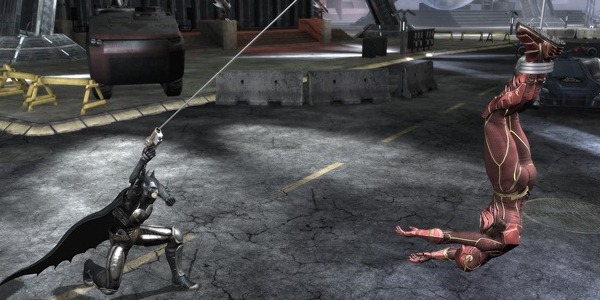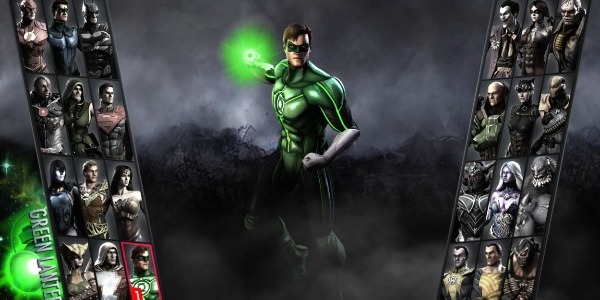A few years back Mortal Kombat changed the way single player fighting games played. Instead of giving you a character-specific ending, there was this story that encompassed all of the characters and had you playing as a handful of them during the course of the story. It was applauded by critics and fans alike, and NetherRealm Studios has carried that formula over to their DC Comics licensed game, Injustice: Gods Among Us.
What Injustice has over Mortal Kombat is the familiar world that it is based upon. Familiarity is always a bonus when trying to tell a story, so even being a casual comic book fan made it easy to follow the story and understand what was happening.
Without spoiling too much, the narrative did a great job of sucking me in and keeping me entertained. Superman plays a believable antagonist after the startling events that open the game. Batman leads the rest of the heroes in an attempt to overthrow the rogue Superman and his faction of pseudo-villains. That is the premise of the story, all taking place in an alternate universe after present-time Batman and his small squad of heroes are teleported to a future dimension.
The story itself was both well-written and directed, filled with rich character interactions that made me chuckle more than once. In typical fashion, Joker and Harley lead the charge as their usual comedy act, while characters like Flash and Green Lantern spiced things up from time to time. The ever-serious Batman played his part well, too. It was exciting to see some of these interactions play out, but it’s hard to pinpoint specific instances and keep things spoiler free. Superman acting as the villain, in particular, was probably the highlight of the game. It’s a very believable scenario, and one I could certainly sympathize with. Well, assuming I was a superhero and all.
Despite the well-versed narrative, the general flow of the story mode put me in an awkward position. While I can appreciate NetherRealm’s effort to keep things fresh by constantly rotating who I was playing, as the game progressed it made for some frustrating experiences. Spending about 15-20 minutes with a particular character, I would get rather good with him. But then I would be thrust into the boots of another character and forced to learn a whole new move set and play style. To make the situation more complicated, the difficulty in the game ramps up gradually (as it should). It wasn’t particularly fun to be totally annihilated my first time playing a late-game character just because I had no idea how that particular character played.
The 24 characters in Injustice: Gods Among Us all fit neatly into stereotypical roles. Batman is played best as a defensive character, Flash is the ultra-quick one, and Superman is… well, Superman. They all have a handful of special moves, and having experience with past NetherRealm Studios games, I had no issue figuring them out. That said, there still is a trick to each character and it’s figuring out which type-set they are.
However, to DC fans or button-mashers, the difference between these similar characters is going to be the super moves, which can be activated by hitting both trigger buttons simultaneously after a meter fills up. Even though these moves are strikingly different, each one of them had the same effect; I winced and squirmed as things just got awful and brutal on the screen. Watching Flash zoom around the world to deliver a terrifyingly powerful punch or Doomsday pummel his opponent through Earth never really got old. It was increasingly gut-wrenching when I had someone walk by for the first time and witness the devastating move unfold.
The beauty of these moves is watching the first few seconds after triggering them. The air in the room thickens with tension (especially if playing with a friend sitting next to you), because even though these super moves are easy to start, actually connecting with them can take either luck or skill. Some lunge further forward than others, and the short cinematic before finding out if the move hits or not is seemingly designed just to build that tension. A thwarted super move usually meant I had a big uphill struggle if I was really counting on it to comeback.
After the story was completed and some versus matches were played, I was left with an assortment of single player options. S.T.A.R.S. Lab is an interesting twist on challenges. Each character has a certain amount of challenges to complete and each challenge has three objectives (ie. opportunities to earn stars). While I found these short little exercises fun and entertaining, some were more difficult and I ended up skipping them. These were fun to pass the time if I didn’t feel like committing to a long play session, I just didn’t get as involved in them as the campaign.
There’s also a series of ladders to play through in single player. I bought all of them with the in-game currency earned while playing, and some of them were way out of my league. One, in particular, is a gauntlet where you face everyone on the roster and can’t die. There’s a nice assortment of ladders, each with their own rule set. I spent more time playing through these than the S.T.A.R.S. Lab, but it still didn’t compare to the story mode.
A casual fighting game player like myself will enjoy playing through the story mode and find themselves ready to pack it up even though NetherRealm Studios has injected a lot of content into the game. After playing around with all of the other modes, I couldn’t get past the high of the campaign. Nothing else captured my interest the way the story did. Sure, it was fun to pick up the game and do a few fights as Doomsday, but the rest of the content caters more to the fighting genre crowd. Brand-specific fans like myself will finish the story to Injustice: Gods Among Us, enjoy the narrative and creative plot, and that’s it.



